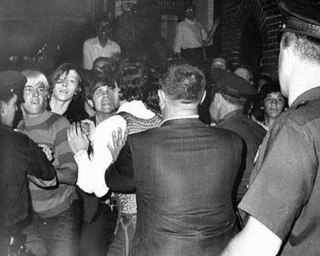
The Stonewall riots were a series of spontaneous protests by members of the gay community in response to a police raid that began in the early morning hours of June 28, 1969, at the Stonewall Inn in the Greenwich Village neighborhood of Lower Manhattan in New York City. Patrons of the Stonewall, other Village lesbian and gay bars, and neighborhood street people fought back when the police became violent. The riots are widely considered the watershed event that transformed the gay liberation movement and the twentieth-century fight for LGBT rights in the United States.

Charles X was King of France from 16 September 1824 until 2 August 1830. An uncle of the uncrowned Louis XVII and younger brother to reigning kings Louis XVI and Louis XVIII, he supported the latter in exile. After the Bourbon Restoration in 1814, Charles became the leader of the ultra-royalists, a radical monarchist faction within the French court that affirmed rule by divine right and opposed the concessions towards liberals and guarantees of civil liberties granted by the Charter of 1814. Charles gained influence within the French court after the assassination of his son Charles Ferdinand, Duke of Berry, in 1820 and succeeded his brother Louis XVIII in 1824.

Philippe II, Duke of Orléans, was a French prince, soldier, and statesman who served as Regent of the Kingdom of France from 1715 to 1723. He is referred to in French as le Régent. He was the son of Monsieur Philippe I, Duke of Orleans, and Madame Elisabeth Charlotte, Duchess of Orleans. Born at his father's palace at Saint-Cloud, he was known from birth by the title of Duke of Chartres.
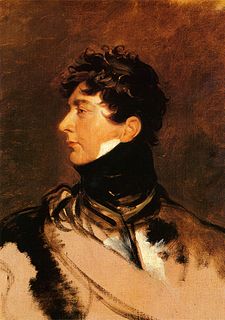
The Regency era of British history officially spanned the years 1811 to 1820, though the term is commonly applied to the longer period between c. 1795 and 1837. King George III succumbed to mental illness in late 1810 and, by the Regency Act 1811, his eldest son George, Prince of Wales, was appointed Prince Regent to discharge royal functions. When George III died in 1820, the Prince Regent succeeded him as George IV. In terms of periodisation, the longer timespan is roughly the final third of the Georgian era (1814–1837), encompassing the last 25 years or so of George III's reign, including the official Regency, and the complete reigns of both George IV and his brother William IV. It ends with the accession of Queen Victoria in June 1837 and is followed by the Victorian era (1837–1901).
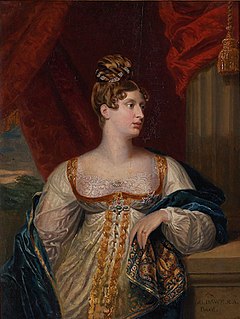
Princess Charlotte Augusta of Wales was the only child of George, Prince of Wales, and his wife, Caroline of Brunswick. She was expected to ascend the British throne after the deaths of her grandfather, George III and her father, but died in childbirth at the age of 21, predeceasing them both.

Maria Karolina Zofia Felicja Leszczyńska, also known as Marie Leczinska, was Queen of France as the wife of King Louis XV from their marriage on 4 September 1725 until her death in 1768. The daughter of Stanisław Leszczyński, the deposed King of Poland, and Catherine Opalińska, her 42-years and 9 months service was the longest of any queen in French history. A devout Roman Catholic throughout her life, Marie was popular among the French people for her numerous charitable works and introduced many Polish customs to the royal court at Versailles. She was the grandmother of Louis XVI, Louis XVIII and Charles X of France.
The Regency Acts are Acts of the Parliament of the United Kingdom passed at various times, to provide a regent in the event of the reigning monarch being incapacitated or a minor. Prior to 1937, Regency Acts were passed only when necessary to deal with a specific situation. In 1937, the Regency Act 1937 made general provision for a regent, and established the office of Counsellor of State, a number of whom would act on the monarch's behalf when the monarch was temporarily absent from the realm or experiencing an illness that did not amount to legal incapacity. This Act, as modified by the Regency Acts of 1943 and 1953, forms the main law relating to regency in the United Kingdom today.
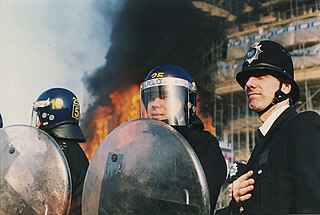
The poll tax riots were a series of riots in British towns and cities during protests against the Community Charge, introduced by the Conservative government of Prime Minister Margaret Thatcher. The largest protest occurred in central London on Saturday 31 March 1990, shortly before the tax was due to come into force in England and Wales.
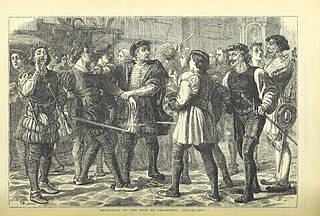
Evil May Day or Ill May Day is the name of a xenophobic riot which took place in 1517 as a protest against foreigners living in London. Apprentices attacked foreign residents ranging from "Flemish cobblers" to "French royal courtiers". Some of the rioters were later hanged although King Henry VIII granted a pardon for the remainder following public pleadings from his wife, Catherine of Aragon.

The Women's March on Versailles, also known as the October March, the October Days or simply the March on Versailles, was one of the earliest and most significant events of the French Revolution. The march began among women in the marketplaces of Paris who, on the morning of 5 October 1789, were nearly rioting over the high price of bread. The unrest quickly became intertwined with the activities of revolutionaries seeking liberal political reforms and a constitutional monarchy for France. The market women and their allies ultimately grew into a mob of thousands. Encouraged by revolutionary agitators, they ransacked the city armory for weapons and marched on the Palace of Versailles. The crowd besieged the palace and, in a dramatic and violent confrontation, they successfully pressed their demands upon King Louis XVI. The next day, the crowd forced the king, his family, and most of the French Assembly to return with them to Paris.

Eleanor of Aragon was Queen of Portugal as the spouse of Edward I of Portugal and the regent of Portugal as the guardian of her son. She was the daughter of Ferdinand I of Aragon and Eleanor of Alburquerque.
The Spa Fields riots were incidents of public disorder arising out of the second of two mass meetings at Spa Fields, Islington, England on 15 November and 2 December 1816.

The Day of the Tiles was an event that took place in the French town of Grenoble on 7 June in 1788. It was one of the first disturbances which preceded the French Revolution, and is credited by a few historians as its start.
The flour riot of 1837 was a food riot that broke out in New York City in February 1837, and lasted less than a day. This violent civil disturbance grew out of a public meeting called by the Locofocos to protest runaway prices, as hungry workers plundered private storerooms filled with sacks of hoarded flour. Commodity prices had skyrocketed over the winter of 1836–37, an inflationary boom fueled by foreign investment and two successive years of wheat crop failures. The riot was also a sign of the impending financial crisis known as the Panic of 1837, that hit the American economy the following month.

The Golden Jubilee of Queen Victoria was celebrated on 20 and 21 June 1887 to mark the 50th anniversary of Queen Victoria's accession on 20 June 1837. It was celebrated with a Thanksgiving Service at Westminster Abbey, and a banquet to which 50 European kings and princes were invited.
The Harelle was a revolt that occurred in the French city of Rouen in 1382 and followed by the Maillotins uprising a few days later in Paris, as well as numerous other revolts across France in the subsequent week. France was in the midst of the Hundred Years' War, and had seen decades of warfare, widespread destruction, high taxation, and economic decline, made worse by bouts of plague. In Rouen, the second largest city in the kingdom, the effects of the war were particularly felt.
The Lhasa riot of 1750 or Lhasa uprising of 1750 took place in the Tibetan capital Lhasa, and lasted several days during the period of the Qing dynasty's patronage in Tibet. The uprising began on 11 November 1750 after the expected new regent of Tibet, Gyurme Namgyal, was assassinated by two Qing Manchu diplomats, or ambans. As a result, both ambans were murdered, and 51 Qing soldiers and 77 Chinese citizens were killed in the uprising. A year later the leader of the rebellion, Lobsang Trashi, and fourteen other rebels were executed by Qing officials.
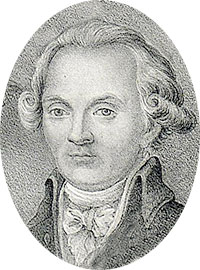
Nils Henric Aschan Liljensparre, born Sivers, was a Swedish police officer. He is most known for conducting the investigation of the regicide of king Gustav III of Sweden in 1792.

The Cádiz Memorial, also known as the "Prince Regent's Bomb", is an early 19th-century French mortar mounted on a brass monster, located in Horse Guards Parade in Westminster, London. It was first "exposed to public view" on 12 August 1816 and has been classified as a Grade II listed building since 1 December 1987. The monument was a feature of many satirical verses and cartoons in the early 19th century, mainly because the word "bomb" – pronounced "bum" – gave it an immediate association with the notoriously profligate Prince Regent's sizeable backside.
The University of Georgia desegregation riot was an incident of mob violence by proponents of racial segregation on January 11, 1961. The riot was caused by segregationist's protest over the desegregation of the University of Georgia (UGA) in Athens, Georgia following the enrollment of Hamilton E. Holmes and Charlayne Hunter, two African American students. The two had been admitted to the school several days earlier following a lengthy application process that led to a court order mandating that the university accept them. On January 11, several days after the two had registered, a group of approximately 1,000 people conducted a riot outside of Hunter's dormitory. In the aftermath, Holmes and Hunter were suspended by the university's dean, though this suspension was later overturned by a court order. Several rioters were arrested, with several students placed on disciplinary probation, but no one was charged with inciting the riot. In an investigation conducted by the Federal Bureau of Investigation, it was revealed that some of the riot organizers were in contact with elected state officials who approved of the riot and assured them of immunity for conducting the riot.













